
A periodic round up of some of the rare and interesting vintage guitars for sale on the web just now: guitars, hard to find parts, catalogs and guitar memorabilia . Anything interesting that catches our eye - maybe a typically expensive guitar going for a great price - something that very rarely comes up, or even just an item with a great story. Got a suggestion for this page? let us know - you can promote your own stuff; if you tell us why it's interesting, it's more likely to be included.
Disclaimer: unless explicitly stated, vintageguitarandbass is not the vendor of any item shown on this page, nor will it be held liable for any unsatisfactory transaction. Please do your own research, look at feedback ratings (where applicable) and deal only with trusted sellers.
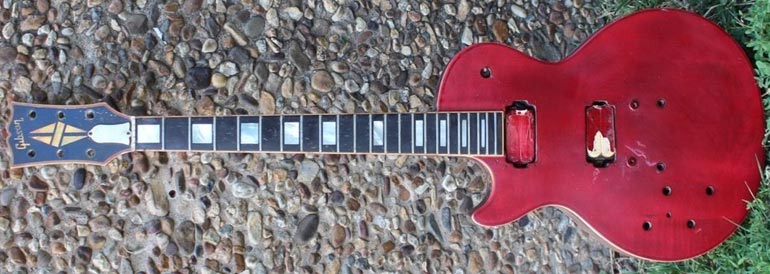
Today we have a rather unloved left handed Gibson Les Paul Custom project. It's been stripped, partially refinished and is missing the vast majority of it's hardware. But it is an original vintage Gibson Les Paul, apparently structurally solid, and with serial number and headstock markings intact. It doesn't seem to have been refretted and the ebony fretboard looks in good condition. As a '76, it has a three-piece maple neck, and there is no evidence (from these images at least) of any headstock break. Luckily, whoever stripped it, left the eight digit decal serial number in place, and the black surround suggests this was an originally all-black (Ebony) finished guitar. Note, this was a 'second' - you can just about make out the stamp below the serial number, but frankly whatever made it a second will have been removed with the original finish.
The Les Paul was probably one of the most widely available lefty Gibson guitars, even though left handed Gibsons are generally hard to find, and vintage examples typically expensive. Right handed Ebony Les Paul Customs are not too rare, with 22811 produced just between 1971 and 1979. A further 824 left handed guitars shipped in the same period. Only 77 Left handed Les Pauls shipped in '76, and 49 of these were in Ebony finish. Despite these relatively high shipping numbers, prices are by no means low. A vintage Les Paul is a wonderful playing and supremely collectable guitar, and many go to investors and collectors, sadly never to be played (seriously at least) again. But this example is a player - and a not too difficult restoration project. It's got a start price of £500 - certainly not a give-away, but worth the opening price without doubt. An opportunity to get a great playing vintage guitar, that is typically out of a lot of players price range.
This guitar is in the UK and available on ebay.co.uk

Rickenbacker is famous for it's 'Cresting Wave' 4000 series bass guitars - with their all maple construction and through-neck. These instruments epitomise the Rickenbacker bass guitar. But in the mid-late seventies, and into the 1980s, (1975-1984) Rickenbacker did produce two quite different models. The short scale 3000 and long scale 3001 were still all-maple with a rosewood fretboard, but with a quite different un-bound body style, and a bolt-on maple/walnut neck. This construction and centrally-located single humbucker take this bass away from a typical 4001 or 4003 - actually far more Fender-esque both in sound and looks. A lot of Rickenbacker players wanted the classic 4001 shape, with associated fire-glo finish and binding, so the 3000 series never sold so well; they are great basses though, increasingly collectable, and somewhat unknown beyond hardcore Rickenbacker fans. And compared to the very steep prices of a new Rickenbacker, these basses are certainly cheap. Not as cheap as they were a decade back, but they are rising in value more rapidly than many other vintage basses. Currently affordable, I predict that these basses will become collector-only instruments (i.e. too rich to gig) in another ten years.
This example dates to April 1977 and is in generally nice condition, with original case. Although available with a less-desirable satin finish, this one has the high-gloss maple-glo finish. Note minor scratchplate damage.
A somewhat rare, increasingly collectable bass available on ebay.co.uk
Now, here we have a seriously cool vintage guitar for sale in the UK. The Hofner President was a very successful guitar in early 1960s Britain. Produced in Germany, of course, and distributed in the UK and much of the commonwealth by Selmer. They sold well, and are not too hard to find today - in the UK at least. The rest of the world had an equivalent model, the 4570. However this one is pretty special. An acoustic President had been available since 1953, with a carved spruce top, with an electric model appearing in 1959. Laminate tops were the norm throughout the 1960s, but some 1959/1960 electric Presidents still had a carved top.
So this is an early example. The serial number (see Selmer / Hofner serial numbers) suggest a pre-1960 guitar - though the toaster pickups show it's not one of the very first. Although listed as 1960/61, i'd be inclined to say 1959/60. In terms of hardware, it's identical to the example shown in the 1960 Selmer catalog. Splitting hairs maybe, but the earlier it is the more likely it is to have a very desirable carved top.
But whatever top it has, this is a truly beautiful guitar. It's the less-common thinline model, in blonde, and (somewhat rarely) complete and totally original. Check out the flamed back. Exceptionally beautiful - certainly rare and in wonderful condition. I expect this to reach a better price than most Presidents, but definitely worth sticking in your watch list.
Check it out on ebay.co.uk
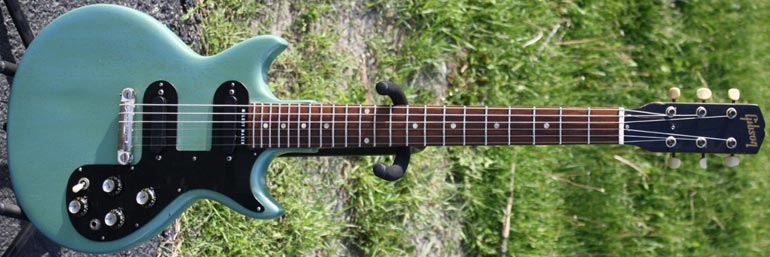
Gibson's rationale for lower priced guitars has changed considerably over the years. At all times, high end models would have fancy binding, ornate inlays and perhaps gold plated hardware, whilst the lower and mid-level guitars would not. But the entry level models were quite different. Today, the cheapest Gibson's have pretty good hardware and build, but are kept low-priced by doing away with time-consuming finishes: they have a 'worn' or 'faded' finish instead. In the 1970s, it was the guitar's construction itself that was different. Bolt-on necks, scratchplate mounted electrics and often alder or maple body woods.
But in the 1960s, the least expensive Gibson guitars were built with fine body woods (mahogany and Brazilian rosewood) and high quality nitrocellulose finishes. Costs were reduced by the fitting of cheaper pickups, and other hardware typically with plastic covers, tuner keys etc. But this means that an exceptionally nice guitar can very easily be upgraded - without modifying the original body. Many pickup manufacturers (e.g. Curtis Novak, and Seymour Duncan) offer P90 and PAF humbucker style replacement pickups the same dimensions as the original. Higher quality tuning keys and intonatable bridges are also available, to be fitted with no modifications to the body.
A gorgeous early sixties Gibson solid body, made from some of the finest woods there are (and no longer available, even on a top end Gibson) with some modern day upgrades, can offer better playability, tone and at least equal performance to anything available today, and at typically far lower price.
An all-original Melody Maker is a collectable, and therefore expensive, guitar - but slightly modded or incomplete examples sell for very reasonable prices. There two examples shown here, 1964 Pelham Blue and 1963 Sunburst are both reasonably enough priced to be the basis of an exceptionally fine playing guitar, or restoration project. Frankly i'd forget the restoration, put in some new pickups and play the hell out of them! Have you upgraded a Melody Maker with new parts? What pickups did you use? comment
Vintage Gibson guitars are very well known - their amplifiers less so. But Gibson made some great little amps in the 1950s and early 1960s, some of which are very well regarded and great for studio use. They didn't ship in as high numbers as Fender amps of the same era, and therefore don't come up so often. What's more, they rarely come up in such amazing condition as this example here. It seems the chrome faceplate of these amps suffer from rust and pitting more readily than other brands - not sure why, they just often seem to be in bad shape. So it's a pleasure to see such a nice example here. The seller describes it as in 'time-capsule' condition - and it is pretty clean. There are some little marks on the chrome - but it is all-original with 12" Jensen speaker and even original Gibson cardboard shipping box! Check out the original catalogue listing for this amp in early 1958.
It's up for auction with a low start price (currently on $200). Barely used examples like this are very rare indeed! One to watch.
Guild have a great reputation as a Guitar builder - vintage Guild guitars are some of the nicest American guitars of the 1960s and 70s, with great workmanship, great materials and some very original and interesting designs. The Guild Starfire is one of the best known models, with both single cut and double cut models. Guild hardware did vary quite considerably, and this example has some quite unusual pickups - for the Starfire at least, appearing more often on the solid body models of the time, like the Polara and Jetstar, and the T-100 Slim Jim and M65 thinlines. But it is all original, and appears to be in great condition.
And what a nice looking guitar, in gorgeous translucent Cherry finish - with original Guild-branded control knobs, scratchplate and tailpiece. It is also listed at a very reasonable price indeed - and further still, the seller is accepting offers. The downside is that this guitar is available for collection only, from Colchester, UK. Great vintage guitar, great price.
Check out this very nice vintage Guild Starfire on ebay.co.uk.
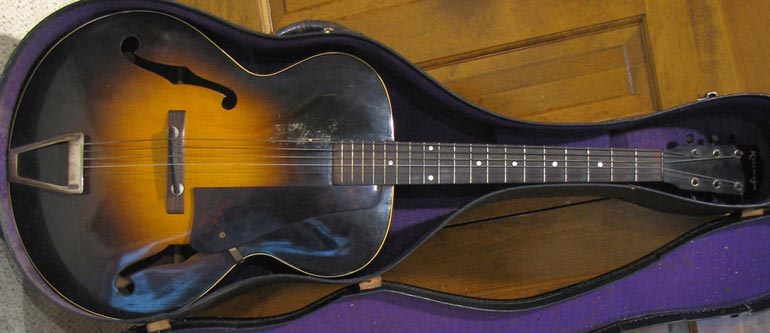
Gibson have always been a premium brand, and that's unlikely to change. But for decades they have offered slightly lower priced instruments to compliment the high end products. Today, these are the Epiphone guitars produced overseas (and to a lesser extent the current faded finish Gibsons), but in the 1930s and early 40s, the entry level 'Gibsons' were still produced at the Parsons Street plant in Kalamazoo, but with the Kalamazoo brand. And these were great guitars, built to similar standards as the Gibsons they were built alongside.
There is not too much detailed information available for these guitars - this one is probably an early 1940s (maybe late 30s) Kalamazoo KG22 acoustic. It has f-holes rather than a soundhole and a beautiful deep sunburst finish. The next model up, the KG32 also had beautiful checkered binding.
Built at a time when even lower priced guitars exuded quality, both in terms of rare woods and skilled assembly. These generally get listed for a (low) four figured sum; this one is on auction (currently at $300) and could prove to be a great deal. Seemingly in nice clean condition, with case and even some interesting case candy (very old Blue Bird strings etc).
It's in Kansas - check it out on ebay.com

This is a really cool old guitar. Beatles instruments don't come up too often, so it's great to see one for sale this month. This is George Harrison's late 1950s Hofner Club 40, and it's available as part of Juliens auctions 2018 music icons auction in New York on May 19th. This was, or course, one of the earlier guitars he used, pre-fame and pre-Gretsch and Rickenbacker. The story is told in the excellent Beatles Gear book by Andy Babiuk: Harrison had an acoustic Hofner President which he exchanged for the Club 40 with Swinging Blue Jeans guitarist Ray Ennis:
"The Club 40 that George got was originally mine. We had our residency on Tuesdays at the Cavern, and I remember we did the swap there. I swapped it for his acoustic Hofner, which was sunburst, with F holes. I haven't got it now - because at the time who thought The Beatles would be so famous. In those early days we used to get fed up with guitars very quickly, so it's swap and change a lot".
Certainly a nice old guitar without the celebrity ownership. It will be interesting to see what this fetches.
See the entire auction catalog at Juliens auctions.
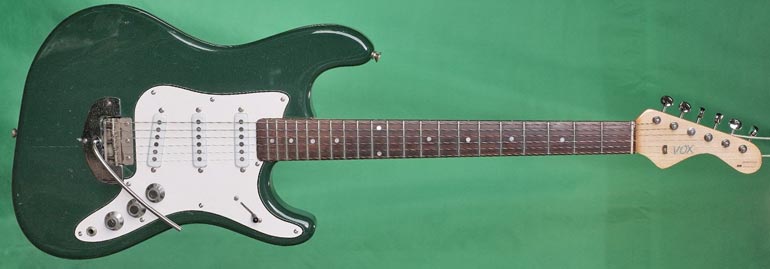
Now this is a rare guitar. Vox guitars were made in a variety of locations worldwide, throughout the 1960s, but the majority of solid body guitars sold in Britain were also built there. Vox's parent company, JMI, was based in Dartford, Kent, and even when the bulk of production moved to Italy in the second half of the 1960s, guitars intended for the UK were still being produced in Dartford. The Vox Soundcaster was the top of the line Vox solid body guitar, at a time when imported Fender guitars were simply too expensive for most British players. Despite being really nice guitars, they never sold well. They were well-built, well finished, and great playing instruments - but probably too expensive compared to other also-good Strat copies. In early 1964, the Soundcaster was listed at £89 5S (the same price as the Vox Phantom) - compared to 55gns (£57 6S 3d) for a Hofner Galaxie, or just 39gns (£40 7S 11d) for the Futurama 3 De Luxe (Hagstrom). At the same time an imported Stratocaster was 165gns (£173 2s 1d). The few Soundcasters that were exported to the US were actually about the same price as a Strat! When JMI went under in 1968, remaining stocks of Vox guitars were sold on. These unsold Vox guitars typically have no serial number, and this is probably the origin of this example.
Original 'Vox' Soundcasters (ie those with serial numbers) are exceptionally rare, but even the originally unsold guitars seldom come up - and when they do, usually have many missing parts. Seeing one with working tremolo is certainly a big deal. This example has a few minor parts missing, and some restoration work, but is still a nice guitar. Certainly rare, historically interesting, and typically a far better playing guitar than the majority of JMI Fender-copies that come up with a greater deal of regularity.
This guitar is in Sheffield, UK, and can be seen on ebay.co.uk
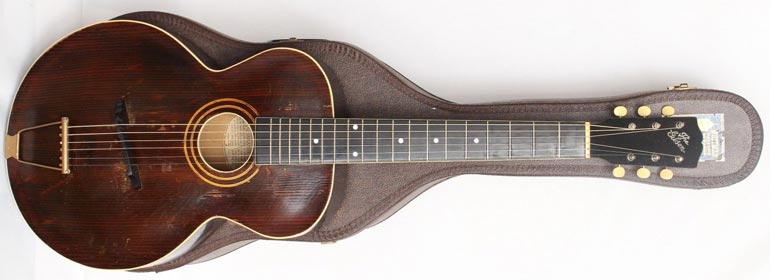
This site is typically about vintage guitars - the great old instruments produced between the 1950s and 1970s. However, when a truly special antique guitar comes up at a ridiculously low price, it would be a crime not to mention it. This wonderful Gibson L1 acoustic is 100 years old, and made at a time when the company was in it's infancy. The legendary Parsons street plant was opened in 1917 - so this would have been one of the earliest guitars made there. Orville Gibson himself died the year this guitar was built, four years before Lloyd Loar even joined the company.
A great old historical piece, with a price tag (currently) of just $100! Check it out on ebay.com.
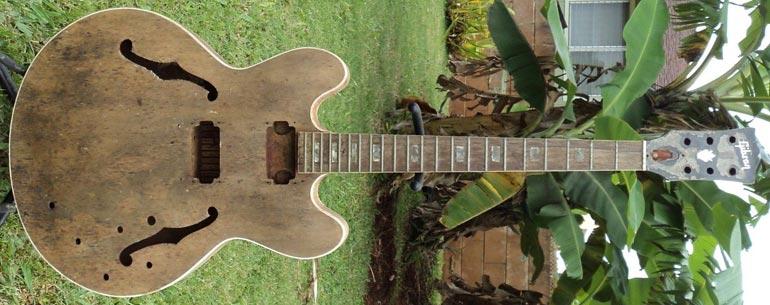
Original 1960s Gibson ES-335s are wonderful instruments - great players and highly collectable. Early 1960s guitars, in particular are particularly revered. The truth is, these guitars sell for five figure sums - out of the reach of many guitarists. So in some ways it is not surprising that an all-but destroyed 335 can still sell for hundreds of dollars. Late 1960s Gibson thinlines are still exceptional instruments, but typically sell for a lower prices - maybe half or a third of an early one, but still a hefty four figure sum. So it's great to see a nice late 1960s Kalamazoo-built ES-335 project with a start price of just $49.99!
This guitar seems original and complete - plus the headstock looks to be unbroken. It has a nice maple body and three-piece mahogany neck. It is stripped of finish of course, but remnants of a Cherry finish can be seen, and the serial number is still present. And a few parts are included with the body. This state of this Gibson project is so much easier to gauge than the burnt-out 335 below, and it will no doubt attract a lot of bids. There is some damage around the f-hole and the neck needs resetting. But all in all this looks like a fairly simple project for a competent luthier.
Find this guitar is in Hawaii, and can be found on ebay.com
Despite being announced in (late) 1965, The Fender Coronado didn't ship until 1966, and the single pickup Coronado I was was pretty much deleted by 1970. So this neck, with a heel date of September 1966 is an early one. These were very cool looking guitars with some fine appointments, designed by Roger Rossmeisl, who previously designed guitars for Rickenbacker. Unfortunately, the pickups were never quite punchy enough for most players, and the Coronado was never the hit that Fender had hoped for. Despite this they are nicely-built, collectable guitars, and though they don't command the prices of a similar period Fender Stratocaster or Telecaster, they are certainly not cheap. So seeing a neck like this for auction with a start price of $29 is pretty amazing. I wonder how many people are restoring a Fender Coronado I though. The price could remain much lower than it is probably worth. Of course this would make a very, very nice neck for a 'partscaster' project.
Complete with string tee, headstock markings and tuner ferrules. Check out this great old neck on ebay.com.
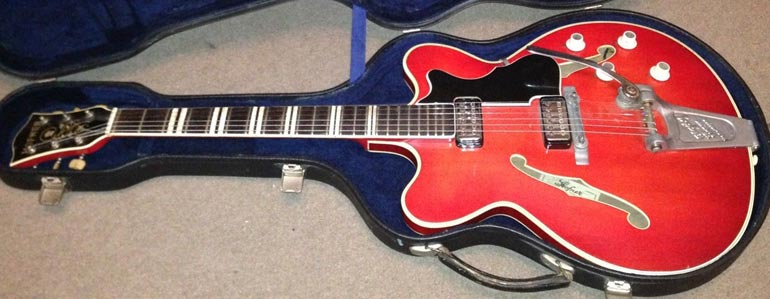
In the early 1960s thinline guitars were in high demand in the UK, but were fairly hard to find. A few solid bodies were being built in Britain, but there was no tradition of building semi acoustics. One of the best guitars available at the time was the Hofner Verithin, built in Germany and distributed by Selmer. Looking back at the bands of the time, shows how many early sixties guitarists favoured these instruments. And it is no surprise: the Verithin was a really cool guitar. Well built Very thin, lightweight and hugely resonant. Some Gibson and Epiphone guitars were available at this time, but at significantly higher prices.
This example is in lovely condition, but is also one of the rare examples with a Bigsby tailpiece as stock (it's mentioned in the label in the soundhole) as opposed to the trapeze style tailpiece more widely seen. This one is up for auction, with a (currently) quite reasonable price, for a nice condition, and all-original Hofner guitar.
Find this guitar on ebay.co.uk
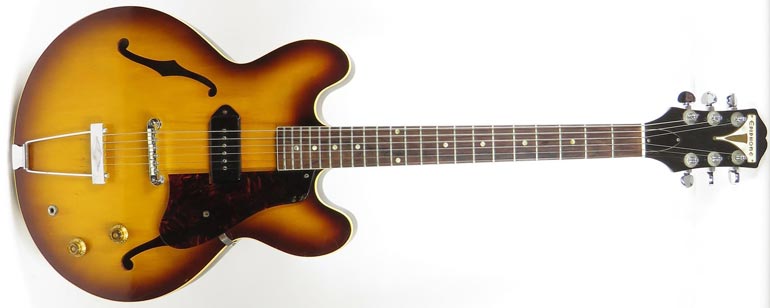
Wow, this is a beauty! The Epiphone Casino was, of course, an equivalent model to the Gibson ES-330TD, produced at the Gibson Kalamazoo plant from 1961. And this very cool first-year guitar is an early one, with a four digit serial number, and Epiphone tin-plate logo - a left over from the pre-Gibson Epiphone stock acquired by Gibson in 1957. The majority of Casinos were dual pickup models (see Casino shipping figures), but it would be wrong to think of these single pickup examples as merely the same with one less pickup. The single P90 is located centrally - rather than in a neck of bridge location) giving these examples their own voice.
This guitar would seem to be in fine original condition, structurally at least - some parts may be replacements (it's hard to see from the images, and the seller does not state anything specifically). Certainly the tuning keys are replacements, and most likely the bridge and tailpiece - probably worth asking about the pickup. But in any case, none of the hardware is unfindable, should you wish to replace them with original nickel-plated parts.
It's certainly unusual to see such a nice guitar listed on ebay at auction rather than with a fixed (and typically high) buy it now price. This guitar starts at $999 - a steal at that price, but naturally it will rise. This gives an opportunity for a bargain, but also informs the rest of us on a notional value for a guitar that doesn't go on the block too often.
Check out this highly collectable guitar on ebay.com
Guild made some wonderful, highly playable guitars in the 1960s - and this is certainly one of them. A very cool D-50 acoustic, produced in 1967. These dreadnought acoustics had a spruce top and beautiful (Brazilian?) rosewood back and sides. A very well built guitar, made from some of the finest tonewoods available.
This Guild is on ebay.com and currently priced below $450
It's hard not to have a soft spot for well-built guitars. As mentioned elsewhere on this page, Premier were the house brand of US distributor Sorkin - though made by Multivox of New York. There were quite a few variants of these 'scroll' guitars, all with the beautifully carved top bout - but this has to be the finest of the fine! As well as having the very cool scroll, the rest of the design is pretty unique too. How many guitars have controls above the strings? The offset nature, but broadly parallel lines of the upper and lower cutaways are particularly appealing - and note a little different from the Premier bass below. Add in the gorgeous symmetrical gold pearloid scratchplates and triple gold pickups - fine is an understatement. The seller claims this guitar to be unique.. who knows? (seen another? please comment). One thing's for sure, Premier guitars in any incarnation are pretty rare.
This guitar is currently on ebay.com. The price is certainly premium, but it certainly isn't an every day guitar.
The point of this page isn't just to point out rare guitars and good deals... also guitars that tell a story. And what a sad story this one tells. A (once) gorgeous 1963 ES-335TD reduced to a lump of blackened charred maple and mahogany. To me the neck looks completely unsaveable. The body looks a little better, but to be honest until you start sanding you'll not know how deep the damage goes. Too often guitars are dismissed as firewood - but seriously what else is this? There are few guitars that a good luthier can't fix, but surely this has to be one that isn't fixable?
It was with some surprise, then, that I had another look at this guitar and was stunned to see, with over two days bidding left, it had had 46 bids! And is currently at $500! I'm guessing that someone thinks it can be restored? Clearly some of you out there can see more potential through the charcoal than I. If you buy this guitar and restore it, i'd love to see how it comes out. A '63 ES-335 is a special guitar indeed, and it would be great to be proved wrong.
See this guitar on ebay.com
EDIT: This 335 project finally sold for $677.
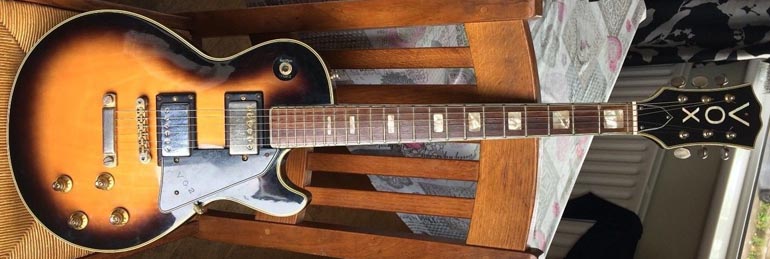
This is a rare guitar that doesn't come up for sale too often. After JMI went under in the late 1960s, Vox's new owners decided to distribute a number of Japanese import guitars with Vox branding. This didn't last long, however and guitars were only really available briefly at the end of the 60s and very early 70s. After this Vox effectively gave up on guitars to concentrate on amplifiers for the rest of the 1970s. Although not as desirable as the better known UK-built and Italian Vox models, these guitars are just as rare, and still somewhat collectable.
So this is a great looking guitar - the VG2 had gold hardware, which in this case has worn somewhat, but nice to see the original scratchplate - something rarely still present on the few VG2s that come up. This one has a replaced bridge pickup (original is there but needs a rewind), but is listed at a suitably low price.
This guitar is available on ebay.co.uk
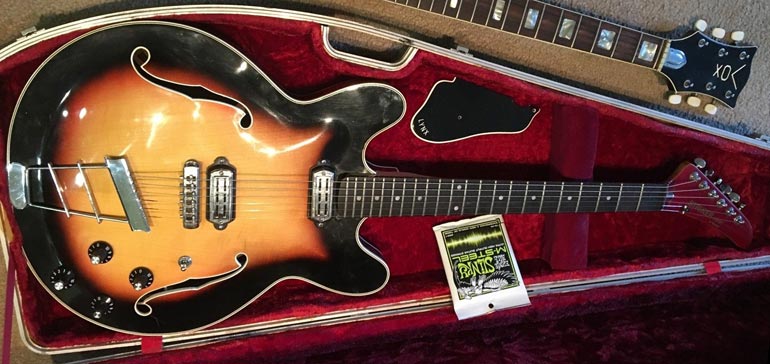
Is there was an award for the most inappropriate neck / body combination on a guitar, this Vox Lynx would be up on the podium, acceptance speech in hand... The gorgeously curvy sunburst Vox body is married with a totally 80s pointy Kramer neck.
But why? surely not an aesthetic choice? These mid-sixties hollow body Vox guitars were built by Crucianelli in Italy before the later Eko/EME semis that are perhaps better known to Vox fans today. And this one (on the surface) looks to be in excellent condition. But a recurring problem with so many of these Crucianelli Vox guitars is that they can suffer from a very high action, and I suspect this is what prompted the neck change. Actually, the pictures still show a high action. It looks like the original neck got the blame? But it may be the body rather than the neck. The wooden block at the neck joint (heel) is susceptible to minor shifts - and a very, very little shift can dramatically affect neck angle. I would suggest that is the case here. But it is fixable by a good luthier, and if so, the original neck may well be completely useable again.
But in any case, this guitar is going cheap (currently $150). It comes with a really nice original hard case - as shipped with some Vox, but also guitars like the Goya Rangemaster. In truth that alone is probably worth the opening bid.
This guitar is located in California, USA, and is currently listed on ebay.com
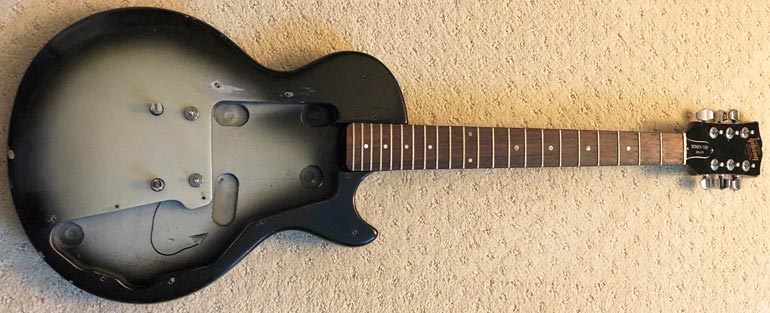
Gibson have produced guitars in the USA with alternate branding for decades - the earliest examples, of course, were the Kalamazoo guitars produced in the 30s, 40s and again in the 60s. As the guitar market got more competitive in the 1970s, with so many imported instruments for sale, being US-built was certainly a selling point. The early 1980s was a time of real experimentation for Gibson, both in terms of construction materials and marketing. They had another go at producing 'Gibson' guitars - note the quotation marks - but without the self-imposed constraints of the actual Gibsons... confused? Have a look at the longer article on Gibson product alignment - or non-Gibson Gibsons. In short Gibson created a new brand 'Gibson Guitar Co.' which were still Gibsons, but could be sold by a whole new tier of dealers and were able to use parts and materials not usually seen on the regular Gibson guitars. This was to be a major new sales initiative, ushering in reams of new affordable models.
The idea didn't really take off, but a few models were produced, and by far the best known of these was the Sonex. There are several versions, some better than others. The guitar shown here, is a 1982 Sonex-deluxe-180 - not an especially rare guitar, although it is quite uncommon to see it in Silverburst finish. These guitars were inexpensive - although produced in the US, the majority of parts are imported. The higher end Sonex guitars (Standard and Custom) were fitted with the well-respected Dirty Fingers pickups, but the Deluxe had some very hot Japanese units. Frankly I don't like them - too hot for me - but i'm an old man - they are great for dirtier guitar tones: punk, metal etc.
It's not clear what is going on with this guitar - all the parts seem to be there (look at the other pics), and it could probably be put back together withing 15 minutes of receiving it. Not sure why the seller didn't do this.
By no means the best guitar to come out of Gibson's Nashville plant, but still a solidly made, great looking vintage guitar with a bit of pedigree. This guitar is in North Carolina and is currently on ebay.com at under $200. Even though this isn't Gibson's finest output, it's a bargain at that price!
High end Gibson jazz guitars appear all the time on ebay - though rarely in a true auction with no reserve. The vast majority of guitars are buy-it-now listings with price tags of several thousand dollars (most Barney Kessels listed now are in the range $4000-$6000, or £3000-£4000). So it's great to see a genuine auction - a rare and exceptionally well-built jazz guitar starting at 99p!
The Gibson Barney Kessel was, of course, part of Gibson's Artist series of high end carved top jazz guitars, this model available between 1961 and 1973. There were two versions: the regular, shown here, with carved spruce top and mahogany neck; and the Custom, with a maple neck and gold hardware. Both great playing, very finely built, and exceptionally collectable vintage guitars
This is the kind of auction that goes to show what a high end guitar is really 'worth', and a potential opportunity to get a real bargain - at least in comparison to the prices suggested by the larger vintage guitar dealerships. We're watching this one closely!
See this auction on ebay.co.uk
Here is a truly beautiful jazz guitar - it's a 1950s (or very early 60s) Roger Junior CA, serial number 1653. Roger guitars were made by Wenzel Rossmeisl in Berlin, Germany. You may know that name - Wenzel was the father of the better-known Roger Rossmeisl (hence the name of this guitar brand). Roger Rossmeisl, of course went on to design a good deal of Rickenbacker's early models, plus the Fender Coronado and Ltd models. But the Roger guitars really are nice. Wenzel was also a jazz guitarist, and knew what he wanted. Note the carved ridge on the front and back of the body. This was known as the 'German carve', a feature designed to increase acoustic volume, that went on to be adopted by Rossmeisl junior's designs for Rickenbacker and Fender.
A very nice hand carved jazz guitar at a far lower price than better-known guitars of similar build. This guitar is listed on ebay.co.uk
These two catalogs are two truly wonderful snapshots of 1930s instrument retail. The 1930/31 Continental Music catalog, and the 1935 Metropolitan Music catalogs. Both listed on ebay.com by the same seller at a $20 start price. Very cool, very rare, and an excellent look at the guitars, banjos, violins, harmonicas and other instruments available in pre-war New York. Brands covered include Regal, Epiphone, Roy Smeck, Harmony.
Two great pieces of early twentieth century guitar history!
Hagstrom made some nice guitars in the 1960s and 70s. They are famous for their low action and easy playing necks - thanks to their special truss rod design. But what let a lot of them down was their lack of traditional controls - instead of volume and tone controls, they typically had a series of tone switches. But in the early seventies, they eventually moved over to a volume/tone control for each pickup. Just like a Gibson SG or Les Paul. This model, the HIIN-0T also features the Hagstrom humbuckers rather than the single coil units of the 60s.
This example is in a nice translucent Cherry, but other finishes were available - check out another HIIN-0T from the same 1972 batch here.
This guitar is complete (original knobs are usually first to go) with case. And currently at a low price. These really are great playing guitars! If you have not tried a Hagstrom before, this (as well as the Swede) is one of the better models to try. Thoroughly recommended!
Check it out on ebay.com
In the early 1960s, British guitar making was rudimentary, to say the least, and American guitars were generally hard to find and largely unaffordable. So many aspiring guitar players started out on imported European guitars - often a Hofner distributed by Selmer, or a re-badged instrument with their own Futurama branding; George Harrison is perhaps the best known example.
The guitar shown above is an early 1960s Futurama II, later named the Futurama Duo. This example was built by CSHN in Czechoslovakia, most likely in 1962 or 63. Check it out in the 1964 Selmer catalogue - though note, by this time the tailpiece had been updated to a smaller unit.
These guitars are somewhat rare - not unfindably so; Selmer sold them in good numbers in the early sixties, but what makes this one so special is its condition. The tremolo arm, knobs and bridge are all present and original, and the plastic machine head cover is also present and unbroken. These were often mistreated in the decades after production and before collectability - finding complete clean examples is indeed unusual.
And on top of that, it's listed at just £125 - 1/4 of what you normally see worse condition/incomplete ones listed for. True, this may have a minor electrical issue (see description) but one that sounds easily fixable.
An interesting and collectable part of early sixties guitar history, in very nice condition. See more pics on ebay.co.uk
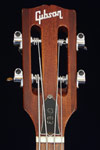
The Gibson EB0 and EB3 have a short period in between 1970-71 when their solid body EB basses (EB0, EB3, EB0L, EB3L) had a classical guitar style slotted peghead - with backwards-facing 'banjo style' Schaller M4C tuning keys. They look like the better known Schaller M4 - but note the string post has a hole through it rather than a slotted end.
Although they are made by Schaller, they are Gibson branded - note 'GIBSON' is on each gear cover. With some machine heads (e.g. the M4) there was a Schaller branded equivalent part - unfortunately, not the case with the M4C. With no direct replacement, the originals are always in demand. This set is in th United Kingdom, listed at £99 - a fair price.
Find them on ebay.co.uk
Although Gibson's financial issues are in the news just now, it has to be remembered that the company has changed hands before. When the Kalamazoo plant closed in the 1980s, a whole lot of unused parts, instruments and tooling was sold off. And a lot of it has been listed for sale on ebay over the last decades. These 'new old stock' items are perfect for restorations and custom builds. A lot of the most wanted stuff were sold a long time back, but some of the more obscure items are still available, and at great prices.
These veneers (the seller has several for sale) are correct for two active models, the the RD Artist guitar and ES Artist. A lot of people call this inlay the Gibson 'Pegasus' headstock. It was designed by Gibson's resident artist Charles Burge.
I interviewed him in 2008, where we discussed the design, and he showed me some of the original templates. I asked him what it he called it:
Flying F hole... well see it's an f-hole... with the wings it's a flying f-hole (laughs). Isn't that wonderful! I design something beautiful and elegant, and what does it become? The flying f-hole.. thanks guys! I came up with the design, I made the three times size templates, and I went out on the Kuhlmann 3D pantograph machine, and cut this myself. This is more like the original. They're all separate parts... See the difference... oh, well I don't have one without the lightening bolt... See there's that design without the lightening bolt too. As soon as we went to onboard active, that's when I put the lightening bolt.
The headstock veneers shown here are from the late 1970s - they are in great condition and at a low price. So why haven't they sold? These are the correct overlays for just two models, both produced in small numbers. Unless one had a catastrophic headstock break, it is unlikely that a new veneer would be required. I suspect these could easily sit unsold on ebay for another decade.
See these items on ebay.co.uk
This is a beautiful bass - one of the very first Gibson Rippers produced, and one of lowest serial numbers we've seen (excluding the 1973 Ripper prototypes). Not too many had this darker Antique Sunburst finish - the precise number isn't known, but certainly not many. Kalamazoo-built, with an all-maple body and neck, and an ebony fretboard. The bulk of production (i.e. those with natural finish) had a maple fretboard.
Naturally this bass has the early less-contoured body, and tortoiseshell scratchplate. Those very first scratchplates were particularly prone to decay: cracks, shrinking and distorting, so it's no surprise that this one is a replacement. But it looks great.
Rippers are great playing instruments - quite unlike most peoples 'idea' of a Gibson bass.
One of the earliest Rippers produced, and seemingly in good original (mostly) condition, with original case. It's a rare bass - priced a little above your average Ripper, but because so few early bursts were made, I suspect it will sell anyway.
See more pictures on ebay.com
EDIT: This rare bass had a start price of $1500, but actually sold for $2,425.00 - maybe a record for a non-celebrity Ripper. But it is a very cool bass!
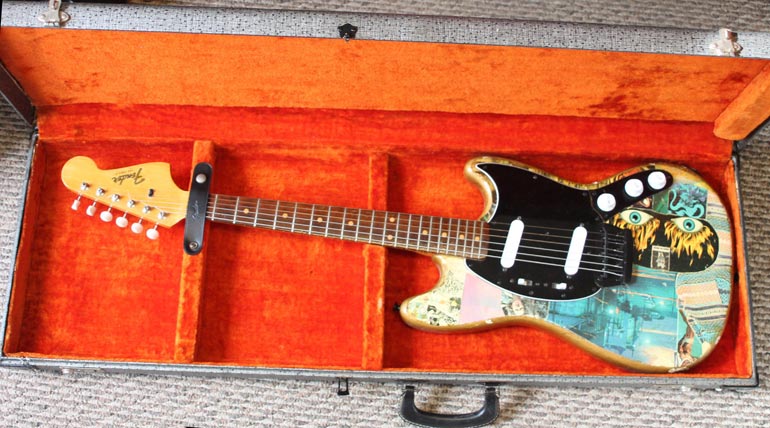
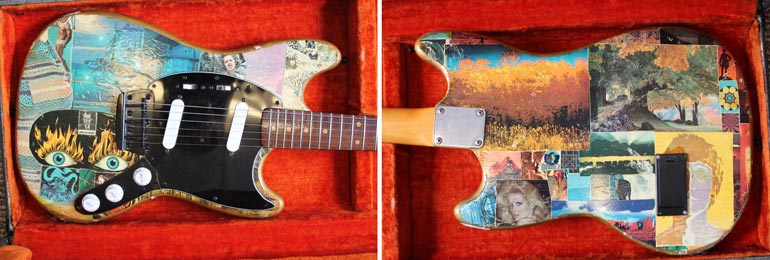
Now this is a cool guitar. The Fender Duo-Sonic was only available up until 1969 - this guitar simply SCREAMS late 60s counter-culture. The model was re-designed in 1964, and dubbed Duo-Sonic II - the serial number suggests this is a '64, so one of the first Duo-Sonic IIs. It isn't a collector, especially: it's got some replaced hardware and a pre-amp (note the added battery enclosure in the reverse) but it's certainly got a lot of soul. I really like it as it is - but as a restoration project it's still got a lot of potential - original neck and case - perhaps some other parts?
Currently with a $500 buy it now on ebay.com
This Gibson EB0 project is being sold as a '71, but in fact is an earlier model - early 1965 by our reckoning - note the 'small' control cavity cover, heel joint and old nickel non-intonatable bridge. Compare with an original condition 1964 EB0 here. This is a nice bass, with the earlier fatter neck profile - yes it's lost it's finish and original humbucker (replaced by a Dimarzio model 1), and has one extra mini-toggle switch hole; but the rest seems to be there. The headstock is unbroken. The original nickel bridge is present - they alone sell for $200 typically.. as are the nickel Kluson tuning keys. It's priced at $699 which isn't super cheap - not worth getting into a bidding war over, but probably worth the opening price.
See pictures on ebay for more
Old items from Gibson's closed Kalamazoo factory (now run by Heritage Guitars) come up for sale with some regularity. Usually guitar parts, unused necks etc. But occasionally tooling, manuals and other unique items get listed. This heat stamp was used to produce Epiphone 'E' logo truss rod covers in the late 1950s and throughout the 1960s (for example, check out a typical Epiphone Rivoli). The seller has several similar, and equally rare items salvaged at some point from Kalamazoo. Great item, exceptionally rare (unique?) and a wonderful insight into how our guitars were made!
Check out this heat stamp on ebay.com
This is a cool and rather rare bass on ebay.com. It is a US-built bass by Premier, who were the house-brand of distributor Sorkin. Premier guitars were built in New York by Multivox throughout the 1950s and 60s, and were not related to Premier drums - a common misconception. So this bass is most likely from the late 1950s - and what a fine instrument. Gorgeous mahogany body with a wonderfully carved scroll on the top horn. Plus gold hardware throughout! Cool. This is the single pickup version, though a dual pickup equivalent also exists. Actually one, two and three pickup six strings were also built, but don't come up too often.
Not a well-known bass, but certainly a well-built one, and historically interesting to those interested in early American electric guitars
Click through to ebay for more
Vintage paper often doesn't hold up so well against the ravages of time - but this January 1952 issue of Musical Merchandise magazine seems to be doing OK. And best of all, it holds a very early Fender advertisement for the Fender Telecaster and Esquire. Cool old advert in great condition.
The magazine is available on ebay.com
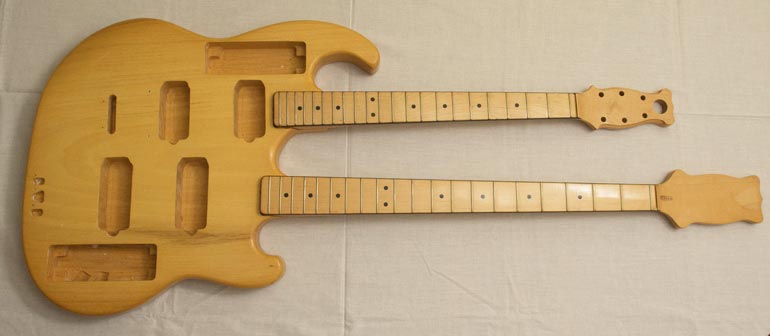
This is a pretty rare item on ebay UK, with an incredible £10 start price. Shergold guitars are pretty unusual in any form, let alone doublenecks. But to see an unfinished double neck guitar / bass is certainly very cool indeed. This could make a very interesting guitar indeed!
According to the original description it was bought direct from the Shergold factory when they stopped making guitars in the early 1980s..
If anyone here buys this, would certainly love to see how it comes out.
Check it out on ebay - more
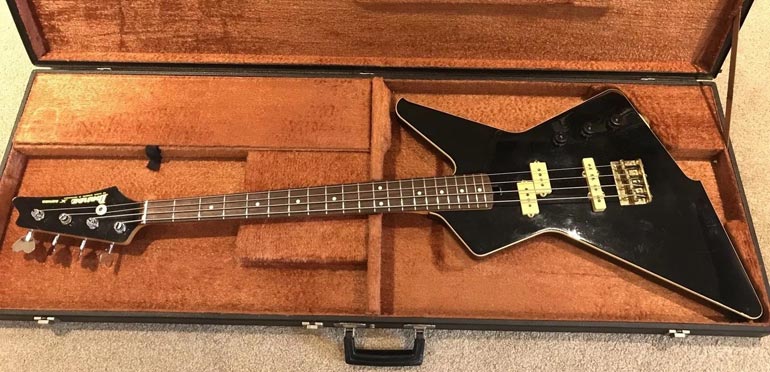
Japanese made Destroyer bass - on ebay UK - one of the better looking Explorer bass type instruments. Rare bass, not seen for sale too often. Nice condition with original case. Certainly a looker - particularly cool with the bound body...
Check it out on ebay - more
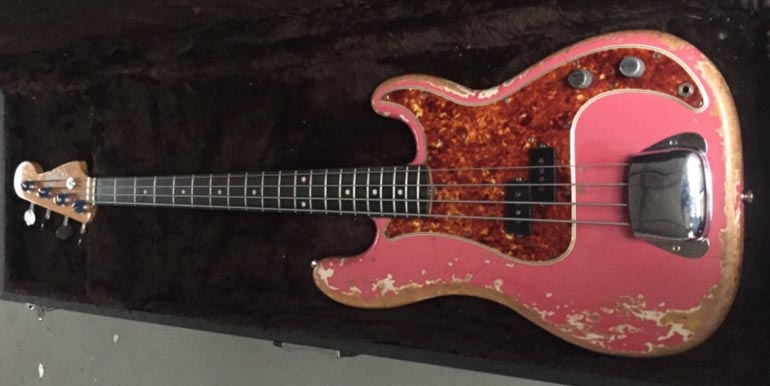
This is a really superb 1960 Fender Precision... but interesting from a historical point of view. Anecdotally the first Precision to make it to the UK? The following comes from the ebay listing
The bass belonged to a friend of mine who bought it (from a reputable music shop in Leicester) in 1966 on the understanding that it was originally Jet Harris' bass and it is built to the Jet Harris spec (red with tortoise shell scratch plate) and, although I have no way of authenticating this, there's a good chance it was as it must be one of, if not the, first Fender bass in the country. I do know that while my friend owned it it was the house bass at Rockfield studio's in Monmouth and I have it on reliable information that it was the bass on the single "I Hear You Knocking" and numerous other recordings.
Check it out on ebay UK - more